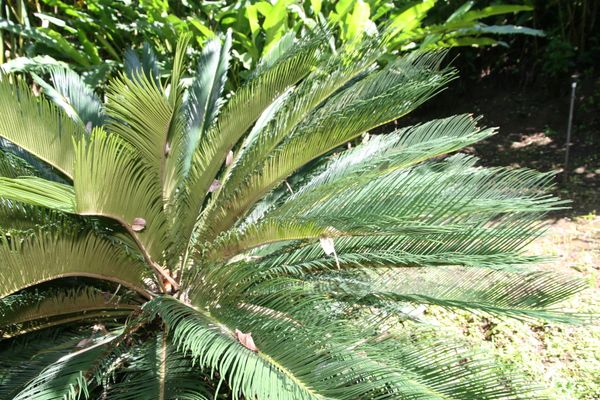Sago Palm Care Guide
How to grow and care for Sago Palm (Cycas revoluta)
The Cycas revoluta, commonly known as the Sago Palm, is a striking indoor plant that adds a touch of elegance and prehistoric charm to any home. Despite its name, it's not actually a palm but a cycad, part of a group of ancient plants that have been around since the time of the dinosaurs. This hardy plant is prized for its feathery, palm-like foliage and can make a spectacular focal point in your indoor garden. It grows slowly and is relatively easy to care for, making it a popular choice among plant enthusiasts.

Disclosure: This content includes affiliate links, which means we may earn a commission if you click on a link and make a purchase. As an Amazon Associate, we earn from qualifying purchases. This comes at no extra cost to you and helps offset the cost of running Leafwise. Please read our disclaimer for more info.
Table of Contents
Care
Light
Sago Palms thrive in bright, indirect light but can tolerate lower light conditions indoors. For optimal growth, place your palm near a south or east-facing window where it receives several hours of filtered sunlight. Avoid prolonged exposure to harsh, direct sunlight, which may scorch the leaves.
Temperature & Humidity
Maintain a temperature range of 60-80°F (15-27°C). While Sago Palms can withstand brief temperature drops, they are susceptible to damage if exposed to temperatures below 50°F (10°C). Indoors, keep them away from drafts, heating vents, and sudden temperature fluctuations.
Sago Palms prefer moderate to high humidity levels. If indoor air is dry, consider using a humidifier, a pebble tray, or occasional misting to maintain adequate moisture levels.
Watering
Sago Palms require infrequent but deep watering. Allow the soil to dry out completely between waterings, then water thoroughly until excess drains from the bottom of the pot. Overwatering can lead to root rot, so ensure the plant is never sitting in standing water.
- Growing season (spring & summer): Water every 7-10 days, depending on humidity.
- Dormant season (fall & winter): Reduce watering to once every 3-4 weeks.
Soil
Use a well-draining, slightly acidic potting mix. A cactus or palm soil blend with added perlite, sand, or bark improves aeration and prevents excess moisture retention. The ideal soil pH is between 5.5 and 6.5.
Fertilization
Feed your Sago Palm with a balanced, slow-release fertilizer every two to three months during the growing season (spring & summer). For best results, use a fertilizer with an 18-8-18 NPK ratio to support leaf development and root health. Avoid fertilizing in fall and winter when growth slows.
Maintenance
Pruning
Trim yellowing or damaged leaves at the base using clean, sharp pruning shears. This helps direct energy toward new growth and maintains the plant’s appearance. Do not remove green fronds, as they contribute to nutrient absorption.
Cleaning
Dust can accumulate on the leaves, reducing their ability to photosynthesize. Wipe leaves gently with a damp cloth to keep them clean and free of pests.
Repotting
Sago Palms grow slowly and only need repotting every 3-4 years. When repotting:
- Choose a pot only slightly larger than the current one to prevent excess moisture retention.
- Ensure the pot has drainage holes to prevent root rot.
- Refresh the soil mix with well-draining, nutrient-rich soil.
Propagation
Sago Palms are most commonly propagated through offsets (pups) that grow at the base of the plant.
How to Propagate via Pups:
- Wait until the offset is at least one-third the size of the parent plant before removal.
- Gently separate the pup using a clean, sharp knife, taking care to preserve its roots.
- Allow the cut end to dry for 1-2 days to prevent rot.
- Plant the pup in a small container with well-draining soil and water lightly.
- Keep in bright, indirect light and maintain consistent humidity while the pup establishes new roots.
Seed Propagation
Seed propagation is also possible but requires patience, as germination can take months. If using seeds:
- Soak them in warm water for 24 hours to aid germination.
- Plant them in moist, sandy soil and maintain a warm (70-80°F) environment.
- Keep the soil lightly moist but not soggy.
Common Issues
Pests
Common pests: Scale insects, mealybugs, and spider mites.
- Symptoms: Sticky residue, white cotton-like clusters, or yellowing leaves.
- Solution: Treat with insecticidal soap or neem oil, and wipe leaves regularly to prevent infestations.
Root Rot
- Symptoms: Soft, mushy roots, wilting leaves, and a foul smell.
- Solution: Reduce watering, ensure proper drainage, and repot in fresh soil if rot is detected.
Yellowing Leaves
- Causes: Overwatering, nutrient deficiency, or natural aging.
- Solution: Adjust watering habits, fertilize during the growing season, and prune only fully yellowed leaves.
Manganese Deficiency
- Symptoms: New leaves appear yellow with brown spots.
- Solution: Apply manganese sulfate to restore proper nutrient levels.
Toxicity Warning
All parts of the Sago Palm are highly toxic to pets and humans if ingested, especially the seeds. Keep the plant out of reach of children and animals.
By following these care guidelines, your Sago Palm (Cycas revoluta) will thrive, adding a timeless and exotic touch to your home decor.
